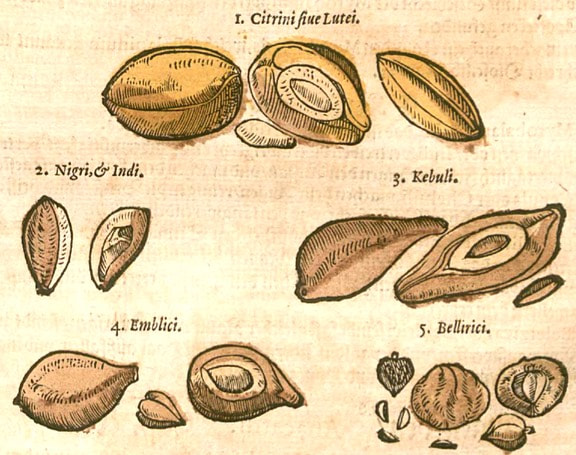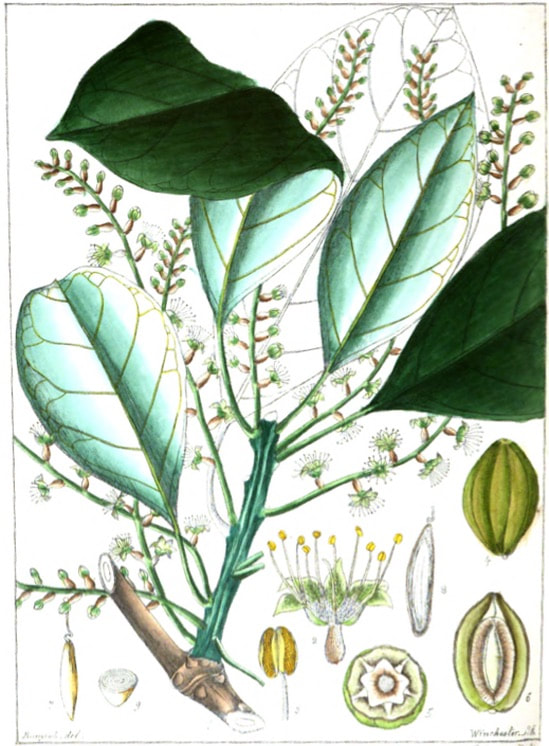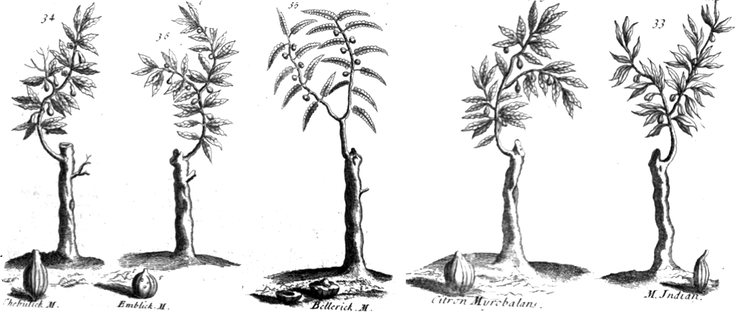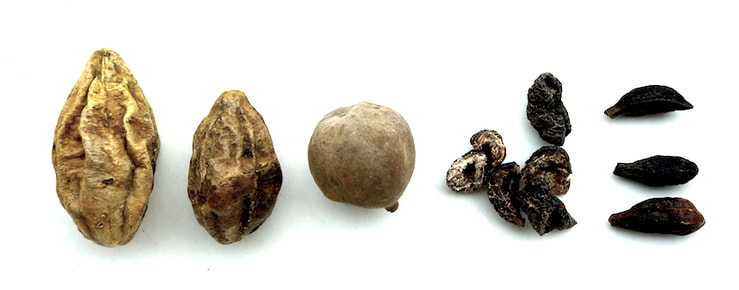Belleric Myrobalan
Illustrations of Indian Botany, Wight, 1840
Illustrations of Indian Botany, Wight, 1840
Chebulic, Emblic, Belleric, Citrine (Yellow) and Indian (Black) Myrobalan
A Complete History of Drugs, Pomet, London, 1748
A Complete History of Drugs, Pomet, London, 1748

1. Yellow (Citrine) Myrobalan
2. Black (Indian, Nigrum) Myroabalan
3. Chebulic Myrobalan
4. Emblic Myrobalan
5. Belleric Myrobalan
Krauterbuch, Lonitzer, 1578
Left to Right: Yellow Myrobalan, Chebulic Myrobalan, Belleric Myrobalan, Emblic Myrobalan (stoned), Black Myrobalan (Adam, 2017)
Botanical name:
Terminalia bellerica
Parts used:
Fruits, stoned
Temperature & Taste:
Warm, dry. Sweet, Sour
Classifications:
2O. ASTRINGENT. 2S. STRENGTHENING
3D. CORDIALS & CARDIACS
4c. CARDIAC
Terminalia bellerica
Parts used:
Fruits, stoned
Temperature & Taste:
Warm, dry. Sweet, Sour
Classifications:
2O. ASTRINGENT. 2S. STRENGTHENING
3D. CORDIALS & CARDIACS
4c. CARDIAC
ADVERTISEMENT:
Uses:
1. Clears Phlegm:
-primary medicine for Phlegm disorders and Phlegm constitutions
-can be used for Phlegm congestion anywhere in the body
-Cough, Asthma, Bronchitis
-Sore Throat, Hoarseness, Dyspnoea and Allergies
2. Astringes to Stop Leakage:
-Diarrhea; also Nocturnal Emission.
-atony, prolapse, catarrh or hemorrhages.
-good for vomiting of Pregnancy.
3. Clears Heat and Toxin:
-Febrile diseases (Chinese Pharmacopoeia)
-Heat-toxin skin diseases including Impetigo
4. Nourishes Blood, Benefits Qi:
-strengthening tonic
-debility during convalescence (Chinese Pharmacopoeia)
5. Clears Damp, Breaks Stones:
-calculi of the Gall Bladder and Urinary Bladders.
6. Externally:
-decoction is used as an eyewash for numerous eye disorders.
-fresh fruit pulp is applied to corneal ulcers.
-the oil from the seeds is used topically for leukoderma and skin diseases.
-the kernel is used topically for inflammation and pain.
-decoction is used as a wash to stop falling of the Hair; if the powder is applied after, it makes the hair blacker (Pemell)
Dose:
Decoction: 3–9 grams;
Powder: 1–3 grams; with Honey to clear Phlegm
Substitutes:
... available in PRO version
Correctives:
... available in PRO version
Comment:
... available in PRO version
Decoction: 3–9 grams;
Powder: 1–3 grams; with Honey to clear Phlegm
Substitutes:
... available in PRO version
Correctives:
... available in PRO version
Comment:
... available in PRO version
Main Combinations:
Triphala
1. Phlegm obstructing the Lungs, Belleric Myrobalan with ... available in PRO version
2. Cough and Asthma, Belleric Myrobalan with ... available in PRO version
3. Urinary stones, Urinary infections, Belleric Myrobalan with ... available in PRO version
4. Insomnia, Belleric Myrobalan with ... available in PRO version
Major Formulas:
‘Pills without which I would not be’ (Nicholas)
Arabian Pills (Nicholas)
Electuary of Life (Arnold de Villa Nova)
Electuarium Alcharif (Mesue)
Electuary of Micleta (Nicholas)
Triphala Electuary of Raisins (Unani)
Triphera of Dodder of Thyme (Mesue)
Triphala Electuary of Dodder (Unani)
Triphala Electuary of Fennel Seeds (Unani)
Triphala Electuary for Epilepsy (Itrifal Zabeeb)
Triphera Persica (Mesue)
Triphera of the Saracens (Triphera Saracenica Magna)
Triphera Minor (Triphera Phoenonis) (Mesue)
Triphala Electuary Lesser (Unani)
Triphala Electuary Greater (Unani)
Triphala Electuary to Purge Phlegm and Black Bile
Frankincense 10 (Spos dkar 10) (Tibetan Medicine)
ADVERTISEMENT:
Cautions:
1. Vata (Wind) conditions and constitutions.
2. Dryness of the Lungs, Skin or Bowels.
3. Mesue said the only deleterious effect of the Myrobalans was their potential to create obstruction. This is why they are regularly mixed with Ghee or Oil and Honey in Ayurveda and Unani. They are also used with medicines to prevent likelihood of obstruction such as Stoechas, Indian Spikenard, Ginger or Pepper etc.
4. Pemell said they should not be used in Obstruction or Fever. They are sometimes used in formulas in these cases with appropriate medicines.
Main Preparations used:
1. Vata (Wind) conditions and constitutions.
2. Dryness of the Lungs, Skin or Bowels.
3. Mesue said the only deleterious effect of the Myrobalans was their potential to create obstruction. This is why they are regularly mixed with Ghee or Oil and Honey in Ayurveda and Unani. They are also used with medicines to prevent likelihood of obstruction such as Stoechas, Indian Spikenard, Ginger or Pepper etc.
4. Pemell said they should not be used in Obstruction or Fever. They are sometimes used in formulas in these cases with appropriate medicines.
Main Preparations used:
Click the Tabs above for more information on this Medicine
|
'Belleric myrobalans, in Sanskrit Vibhitaki, are considered by Hindu physicians to be astringent and laxative, and are prescribed in affections of the throat and chest. As a constituent of the triphala (three myrobalans), they are employed in a great number of diseases. The kernel of the fruit is narcotic if taken in large quantity, and is sometimes used as an external application to inflamed parts. (Sarangadhara.)
Formulae for the administration of this myrobalan as a pectoral will be found in Dutt's Hindu Materia Medica. Mahometan writers describe it as astringent, tonic, |
attenuant, and aperient, useful in dyspepsia and bilious headache, also as an astringent application to the eyes. Belleric myrobalans are only briefly noticed by European writers upon Indian drugs. There is no doubt about the narcotic properties of the kernel. The part used in medicine is the pulp. The tree produces a quantity of gum. In the Concan the kernel, with that of the marking nut, is sometimes eaten with betel nut and leaf in dyspepsia; the fruit also is used as an astringent usually in combination with Chebulic myrobalans. (Vegetable Materia Medica of Western India, Dymock, 1885)
|





